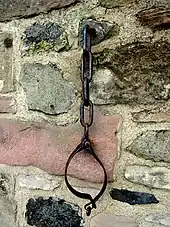Old Scottish Poor Law
The Old Scottish Poor Law was the Poor Law system of Scotland between 1574 and 1845.[1]

Origins
Population growth and economic dislocation from the second half of the sixteenth century led to a growing problem of vagrancy. The government reacted with three major pieces of legislation in 1575, 1579 and 1592. The kirk became a major element of the system of poor relief and justices of the peace were given responsibility for dealing with the issue. The 1575 act, enabled through a Convention of the Estates, was modelled on the English act passed two years earlier and limited relief to the deserving poor of the old, sick and infirm, imposing draconian punishments on a long list of "masterful beggars", including jugglers, palmisters and unlicensed tutors. Parish deacons, elders or other overseers were to draw up lists of deserving poor and each would be assessed. Those not belonging to the parish were to be sent back to their place of birth and might be put in the stocks or otherwise punished, probably actually increasing the level of vagrancy. Unlike the English act, there was no attempt to provide work for the able-bodied poor.[2] In practice, the strictures on begging were often disregarded in times of extreme hardship.[3] This legislation provided the basis of what would later be known as the "Old Poor Law" in Scotland, which remained in place until reforms in 1845.[4] In most of Scotland a Poor Rate (local property tax for the relief of the poor) was not levied before the act of 1845.
Later development
Most subsequent legislation built on the principles of provision for the local deserving poor and punishment of mobile and undeserving "sturdie beggars". The most important later act was that of 1649, which declared that local heritors were to be assessed by kirk session to provide the financial resources for local relief, rather than relying on voluntary contributions.[5] The system was largely able to cope with the general level of poverty and minor crises, helping the old and infirm to survive and provide life support in periods of downturn at relatively low cost, but was overwhelmed in the major subsistence crisis of the 1690s.[6]
References
- "Archived copy". Archived from the original on 5 February 2015. Retrieved 22 August 2009.
{{cite web}}: CS1 maint: archived copy as title (link) - J. Wormald, Court, Kirk, and Community: Scotland, 1470-1625 (Edinburgh: Edinburgh University Press, 1991), ISBN 0748602763, pp. 166-8.
- R. Mitchison, Lordship to Patronage, Scotland 1603-1745 (Edinburgh: Edinburgh University Press, 1983), ISBN 074860233X, p. 143.
- R. Mitchison, The Old Poor Law in Scotland: the Experience of Poverty, 1574-1845 (Edinburgh: Edinburgh University Press, 2000), ISBN 0748613447.
- R. Mitchison, A History of Scotland (London: Routledge, 3rd edn., 2002), ISBN 0415278805, p. 96.
- R. Mitchison, Lordship to Patronage, Scotland 1603-1745 (Edinburgh: Edinburgh University Press, 1983), ISBN 074860233X, pp. 127 and 145.